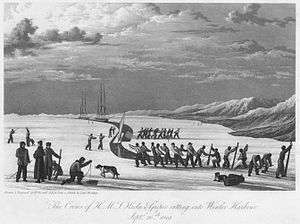Hecla-class bomb vessel
 | |
| Class overview | |
|---|---|
| Name: | Hecla |
| Builders: |
|
| Operators: |
|
| In service: | 1814 - 1857 |
| Planned: | 12 |
| Completed: | 8 |
| Cancelled: | 4 |
| Retired: | 8 |
| General characteristics | |
| Type: | Bomb vessel |
| Tons burthen: | 372 1⁄94 tons bm |
| Length: |
|
| Beam: | 28 ft 6 in (8.7 m) |
| Depth of hold: | 13 ft 10 in (4.22 m) |
| Propulsion: | Sails |
| Sail plan: | Full rigged |
| Complement: | 67 |
| Armament: |
|
The Hecla class was a class of bomb vessels of the Royal Navy of the early 19th century. They were designed for use as bomb or mortar ships and were very heavily built. Eight ships were launched; all were converted for use as exploration or survey ships. Four ships of the class are known for the role they played in Arctic and Antarctic exploration.
Ships
- Builder: Mrs Mary Ross, Rochester
- Ordered: 5 June 1813
- Laid down: September 1813
- Launched: 4 April 1814
- Completed:
- Notes: Converted to Arctic discovery vessel in 1821
- Fate: Bilged in Prince Regent Inlet, and abandoned in the Arctic on 25 August 1825
- Builder: Barkworth & Hawkes, North Barton (Hull)
- Ordered: 5 June 1813
- Laid down: July 1813
- Launched: 22 July 1815
- Completed:
- Notes: Arctic discovery vessel from 1819 to 1827. Converted to survey ship in December 1827
- Fate: Sold on 13 April 1831
- HMS Infernal
- Builder: Barkworth & Hawkes, North Barton (Hull)
- Ordered: 5 June 1813
- Laid down: July 1813
- Launched: 26 July 1815
- Completed:
- Notes:
- Fate: Sold on 13 April 1831
- Builder: Pembroke Dockyard
- Ordered: 18 May 1819
- Laid down: May 1820
- Launched: 25 June 1823
- Completed: 26 July 1823
- Notes: Survey ship, renamed HMS Beacon in June 1832
- Fate: Sold on 17 August 1846
- HMS Aetna
- Builder: Chatham Dockyard
- Ordered: 18 May 1819
- Laid down: September 1821
- Launched: 14 May 1824
- Completed: June 1824
- Notes: Converted to survey ship in 1826. Receiving ship at Portsmouth in 1839.
- Fate: Sold on 20 February 1846
- Builder: Chatham Dockyard
- Ordered: 18 May 1819
- Laid down: May 1824
- Launched: 26 January 1826
- Completed: 21 February 1826
- Notes: The last bomb-ship in Royal Navy service. Converted to survey ship in December 1835. Receiving ship at Woolwich from May 1843
- Fate: Broken up by 20 November 1857
- HMS Thunder
- Builder: Deptford Dockyard
- Ordered: 18 May 1819
- Laid down: November 1826
- Launched: 4 August 1829
- Completed: 26 October 1829
- Notes: Converted to survey ship in January 1833
- Fate: Broken up in March 1851
- HMS Vesuvius
- Builder: Deptford Dockyard
- Ordered: 18 May 1819 (Order transferred to Chatham Dockyard, reordered on 30 August 1828)
- Laid down: August 1830
- Launched:
- Completed:
- Notes:
- Fate: Cancelled on 10 January 1831
- HMS Devastation
- Builder: Plymouth Dockyard
- Ordered: 18 May 1819
- Laid down: 1820
- Launched:
- Completed:
- Notes: Suspended on 10 January 1831
- Fate: Cancelled on 11 July 1833
- HMS Volcano
- Builder: Plymouth Dockyard
- Ordered: 18 May 1819
- Laid down: 1821
- Launched:
- Completed:
- Notes: Suspended on 10 January 1831
- Fate: Cancelled on 11 July 1833
- HMS Belzebub
- Builder: Plymouth Dockyard
- Ordered: 18 May 1819
- Laid down:
- Launched:
- Completed:
- Notes: Suspended on 10 January 1831
- Fate: Cancelled on 11 July 1833
- Builder: Pembroke Dockyard
- Ordered: 9 January 1823
- Laid down: October 1824
- Launched: 7 June 1826
- Completed: February 1828
- Notes: Arctic discovery vessel in 1839, fitted with screw in 1845
- Fate: Abandoned in Arctic on 22 April 1848
Service
Fury and Hecla sailed with William Edward Parry on his explorations in search of the Northwest Passage, with Fury being lost to ice on the second. Meteor was renamed Beacon and used as a survey ship, while Aetna and Thunder were both used as survey ships. Sulphur was also used as a survey ship, at one time being commanded by Edward Belcher who later commanded an expedition in search of John Franklin (though not in Sulphur). Erebus was one of two ships commanded by James Clark Ross during his exploration of Antarctica and by Franklin on his ill-fated search for the Northwest Passage. The other was the Vesuvius-class bomb vessel Terror. Both ships were lost during this last voyage.
References
- Colledge, J. J.; Warlow, Ben (2006) [1969]. Ships of the Royal Navy: The Complete Record of all Fighting Ships of the Royal Navy (Rev. ed.). London: Chatham Publishing. ISBN 978-1-86176-281-8. OCLC 67375475.]
- Winfield, Rif (2007). British Warships of the Age of Sail 1794–1817: Design, Construction, Careers and Fates. Seaforth. ISBN 1-86176-246-1.